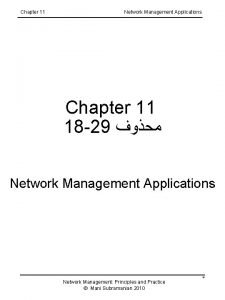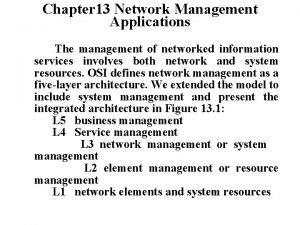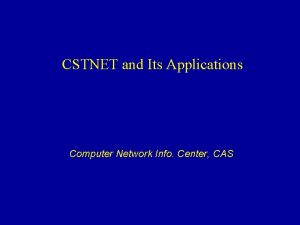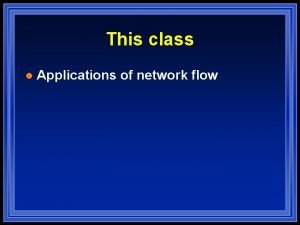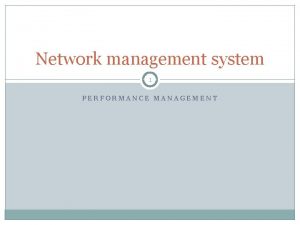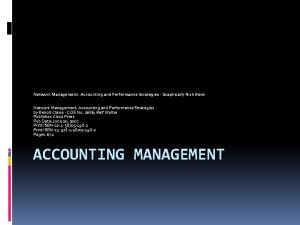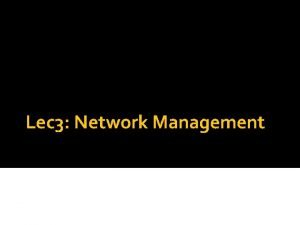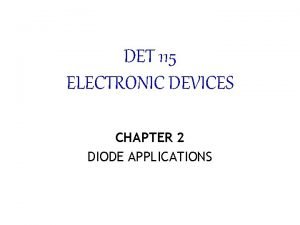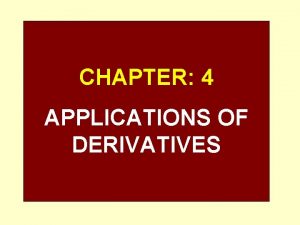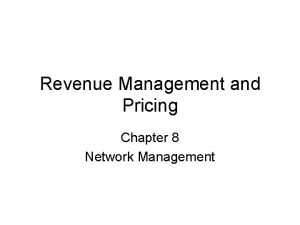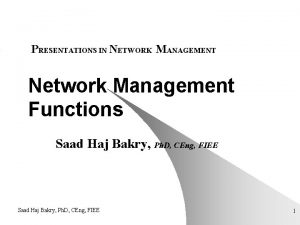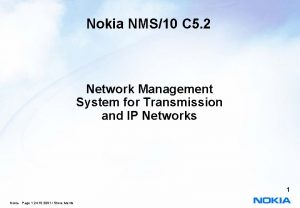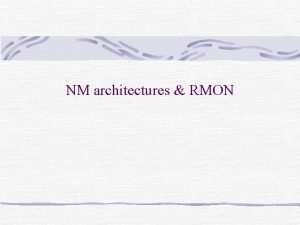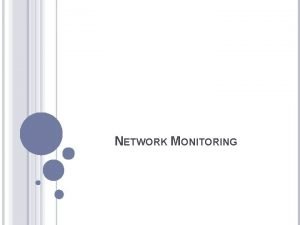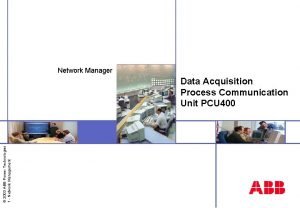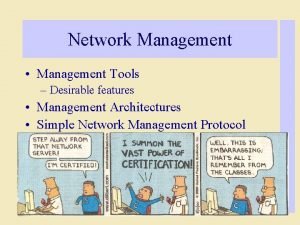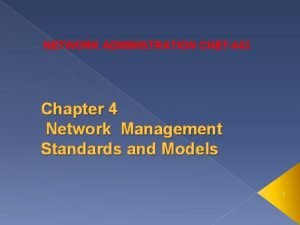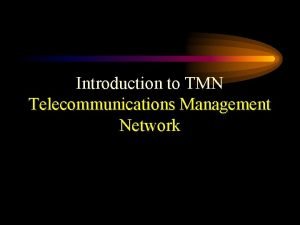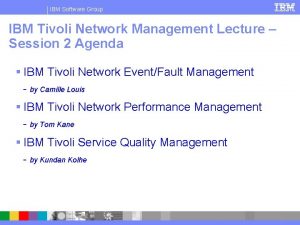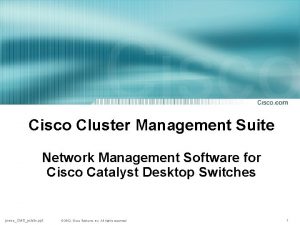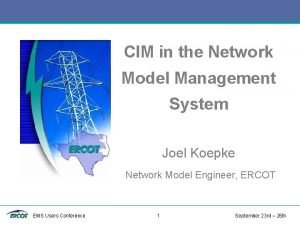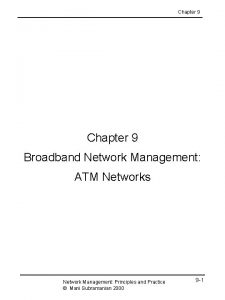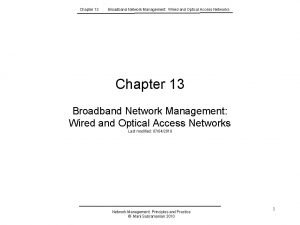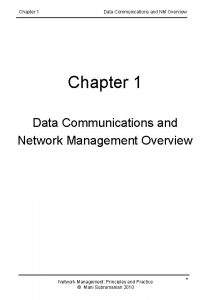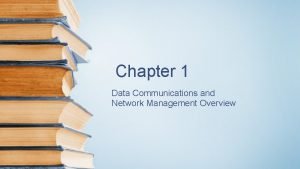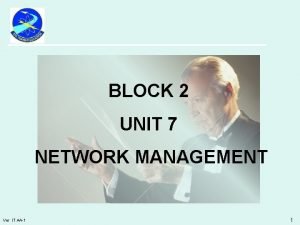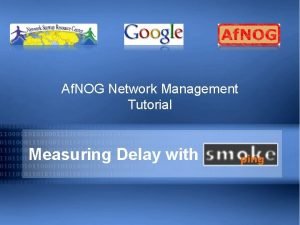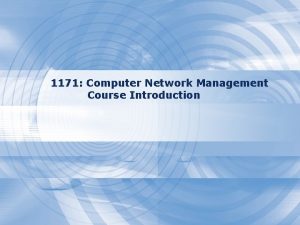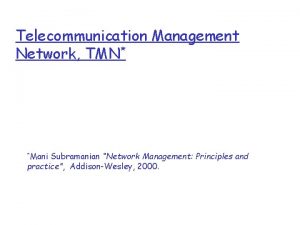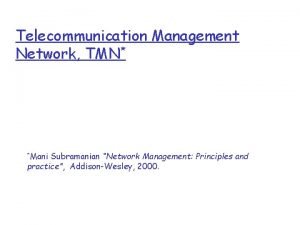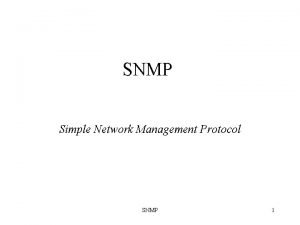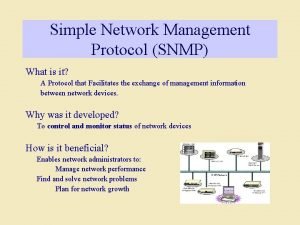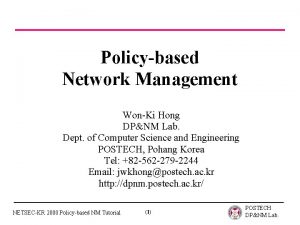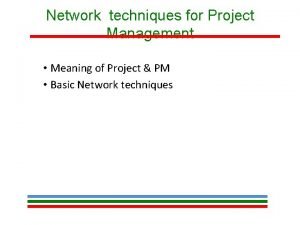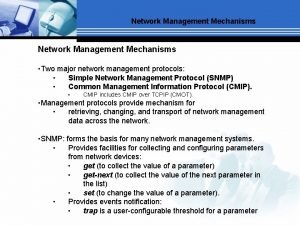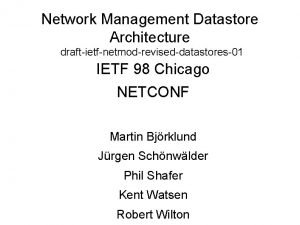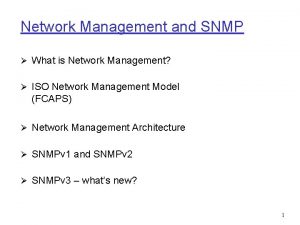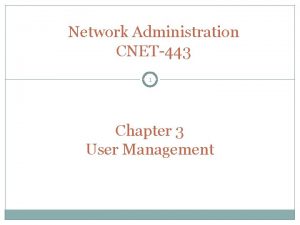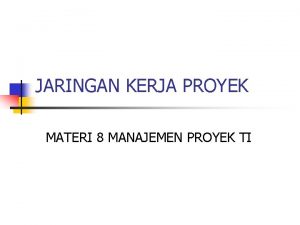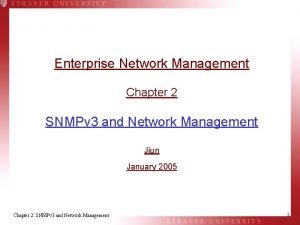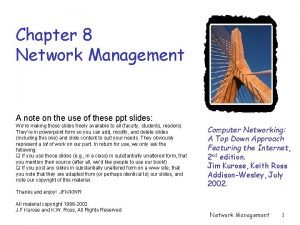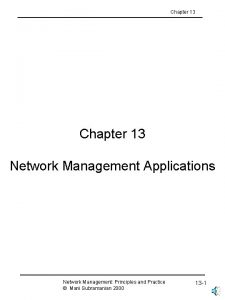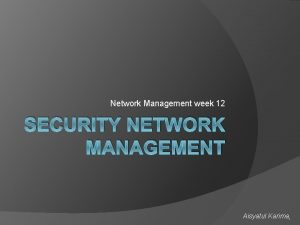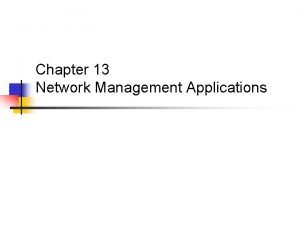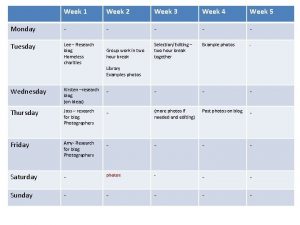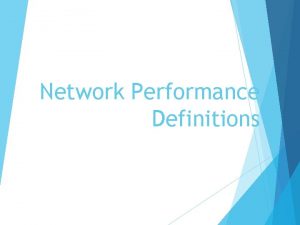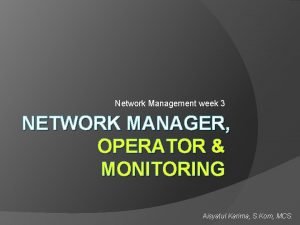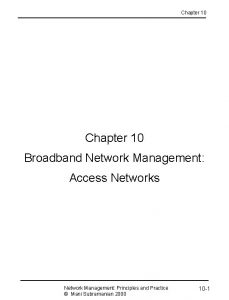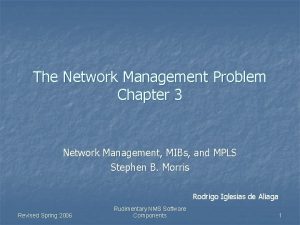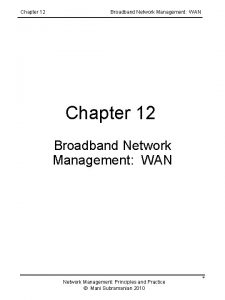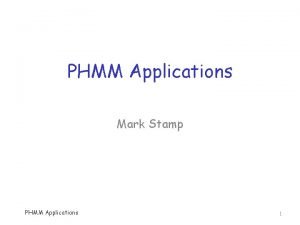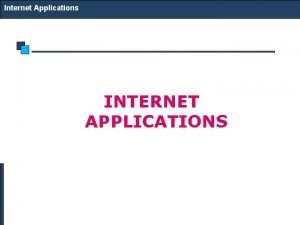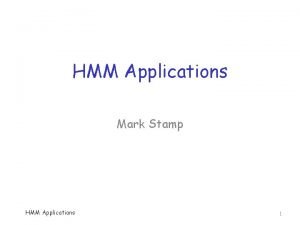Chapter 11 Network Management Applications Chapter 11 Week






































































- Slides: 70

Chapter 11 Network Management Applications Chapter 11 Week 9 Network Management Applications Chapter 11 in Subramanian, Gonsalves & Rani (2010) – All sections do not consider slides from 18 to 29, so do not consider • Rule-based reasoning • Model-based reasoning • Case-based reasoning

Chapter 11 Network Management Applications Objectives • Network management and system management • • Network management • • Configuration • Fault • Performance • Security • Accounting Configuration management • Service/Network provisioning • Inventory management Fault management • Fault detection and isolation • Correlation techniques for root cause analysis Performance management • Performance metrics • Data monitoring • Problem isolation • Performance statistics • • Security management • Security policies and procedures • Security threats • Firewall • Cryptography: keys, algorithms, authentication, and authorization schemes • Secure message transfer methods Accounting management Report management Policy-based management Service level management • Quality of service, Qo. S • Service level agreement, SLA

Chapter 11 Network Management Applications Network and Systems Mgmt five layers of management 1 2 The management of networked information services involves management of network and system resources. OSI defines network management as a five-layer architecture. We have extended the model to include system management and have presented the integrated architecture in Figure 11 1. At the highest level of TMN are the functions associated with managing the business, business management. An institution is a business that provides either a product or service. The third layer of TMN deals with network management or system management. Network management manages the global network by aggregating and correlating data obtained from the element management systems. 3 4 the system management aggregates and coordinates system resources by acquisition of data from the resource management systems. 5 Notes • TMN architecture expanded to include systems management The complementary functions of network and system management manage the networked information system composed of network elements and system resources. Our focus in this chapter will be on network management applications. As we learned in Chapter 3, there are five different categories of applications: configuration management, fault management, performance management, security management, and account management.

Chapter 11 Network Management Applications • OSI Model 1. Configuration 2. Performance 3. Fault 4. Security 5. Accounting • Reports • Service Level Management • Policy-based management Notes The configuration management not only from an operational viewpoint, but also from engineering and planning viewpoints, we have included network provisioning and inventory management. Fault management involves detection of a fault as it occurs in the network, and subsequently locating the source of the problem. We should finally isolate the root cause of the problem. We discuss performance management in Section 11. 3. We will discuss performance metrics and learn how to monitor a network for performance. Performance statistics play a very important part in network management, and several system tools available for gathering statistics will be covered. Security in network is concerned with preventing illegal access to information by unauthorized personnel. It involves not only technical issues, but also establishment of well-defined policies and procedures. The business health of an institution or corporation depends on wellmaintained accounting management and reporting. Reports for management have a different purpose. There are reports needed for the user to measure the quality of service to be provided by service level agreement (SLA). We have addressed the five layers of management with • network elements being at the lowest level • and business management being at the top. • Element management at the second layer maintains the network. • Network management at the third level and • service management at the fourth level are based Not just on technical issues but also on policy issues.

Chapter 11 Network Management Applications Configuration Management • Network Provisioning • Inventory Management • Equipment • Facilities • Network Topology • Database Considerations Configuration management in network management is normally used in the context of discovering network topology, mapping the network, and setting up the configuration parameters in management agents and management systems. However, as discussed in Section 1. 9 and shown in Figure 1. 21, network management in the broad sense also includes network provisioning. Notes Network provisioning includes network planning and design and is considered part of configuration management.

Chapter 11 Network Management Applications Circuit Provisioning • Network Provisioning • Provisioning of network resources • Design • Installation and maintenance • Circuit-switched network • Packet-switched network, configuration for • Protocol • Performance • Qo. S • ATM networks Notes • Examples: • TIRKS (Trunk Integrated Record Keeping System) for circuit-switched networks • E 1 in TIRKS for equipment management • F 1 in TIRKS for facilities management Inventory Management We have addressed the importance of inventory management in circuit provisioning. We need to be aware of all the details associated with components. TIRKS, which is a system of systems. Two of the systems that TIRKS uses are equipment inventory (El) and facilities inventory (Fl). The El system has an inventory of all equipment identifying what is currently available and what will become available in the future with dates of availability. Similar information is maintained on facilities by the Fl system. Network provisioning, also called circuit provisioning in the telephone industry. The design of a trunk and a special service circuit is done by application programs written in operation systems. Planning systems and inventory systems are integrated with design systems to build a system of systems. Thus, a circuit designed for the future automatically derives its turn-up date from the planning system and ensures that the components are available in the inventory system. the design system is made aware of the availability of components for future designs. An example of a circuit provisioning system is a system of systems developed by Bell System (before it was split), called Trunk Integrated Record Keeping System (TIRKS). TTRKS is used in automated circuit provisioning of trunks. A trunk is a logical circuit between two switching offices and it traverses over many facilities. TIRKS is an operations system in the context of Telecommunications Management Network (TMN) that we dealt with in Chapter 10. Given the requirements of a trunk, such as transmission loss and noise, type of circuit, availability date, etc. , as input to the system, the system automatically designs the components of the trunk. The designed circuit will identify transmission facilities between switching offices and equipment in intermediate and end offices. The equipment will be selected based on what would be available in the future when the circuit needs to be installed. Network provisioning for packet-switched network is based on performance statistics and quality of service requirements. Network provisioning in broadband wireless area network (WAN) communication using ATM technology is more complex. The switches are cell -based, in contrast to frame-based packet switching. Each ATM switch has knowledge of the virtual path-virtual circuit (VP-VC) of each session connection only to the neighboring nodes and not end-to-end. The architecture of end-to-end provisioning of ATM circuits could be either centralized or distributed, and is based on whether the circuit is a permanent virtual circuit (PVC) or a switched virtual circuit (SVC).

Chapter 11 Network Management Applications Network Topology • Manual (uses the arp command ) • Autodiscovery by NMS using • Broadcast ping • ARP table in devices • Mapping of network • Layout • Layering • Views • Physical • Logical Notes Network management is based on knowledge of network topology. As a network grows, shrinks, or otherwise changes, the network topology needs to be updated automatically. The discovery process for example, uses the arp command to discover any network component that responds with an IP address. Autodiscovery can be done using the broadcast ping. The more efficient method is to look at the ARP cache in the local router. The ARP cache table is large and contains the addresses of all the recently communicated hosts and nodes. A map, showing network topology, is presented by the autodiscovery procedure after the addresses of the network entities have been discovered. The autodiscovery procedure becomes more complex in the virtual local area network (LAN) configuration.

Chapter 11 Network Management Applications Traditional LAN Configuration Figure 11. 2 shows the physical configuration of a conventional LAN. The router in the figure can be visualized as part of a backbone (not shown). There are two LAN segments connected to the router, Segment A and Segment B. They are physically connected to two physical ports in the router. They are identified as Port A and Port B, corresponding to Segment A and Segment B, respectively. Both LANs are Ethernet LANs and use hub configuration. Two hosts, A 1 and A 2, are connected to Hub 1 on LAN segment A and two hosts, B 1 and B 2, are connected to Hub 2 on LAN Segment B. Figure 1 1. 3 shows the logical configuration for Figure 1 1. 2. The logical configuration is what the autodiscovery process detects. It is very similar to the physical configuration. Segment A corresponds to LAN on Hub 1 with the hosts A 1 and A 2. It is easy to conceptually visualize this and easy to configure. Notes • One-to-one mapping between physical and logical configuration

Chapter 11 Network Management Applications Virtual LAN Configuration Let us now contrast Figure 11. 2 with Figure 1 1. 4, which shows the physical configuration of two virtual LANs (VLAN). We notice that only one physical port, Port A, is used in the router, not two as in the case of a traditional LAN. Hosts A 1 and A 2 are configured to be on VLAN 1, and hosts B 1 and B 2 are configured to be on VLAN 2. Although VLAN grouping can be done on different criteria, let us assume that it is done on port basis on the switch. Thus, the two ports marked Segment A on the switch are grouped as VLAN 1. The other two ports, marked Segment B, are grouped as VLAN 2. Thus, Segment A corresponds to VLAN 1 and Segment B corresponds to VLAN 2. We observe that VLAN 1 and VLAN 2 are spread across the two physical hubs, Hub 1 and Hub 2. With a layer-2 bridged network, the VLAN network is efficient. As IEEE 802. 3 standards are established and widely adopted, this configuration has been deployed more and more, along with a backbone network. The logical view of the physical VLAN configuration shown in Figure 11. 4 is presented in Figure 11. 5. We see that Hosts A 1 and A 2 still belong to Segment A, but are on different hubs. Likewise, Hosts B 1 and B 2 belong to Segment B. The autodiscovery process would not detect the physical hubs that are identified in Figure 11. 5. In many situations, the switch would also be transparent, as there are no IP addresses associated with switch ports. Consequently, it would be harder to associate the logical configuration with the physical configuration. Notes • Physical and logical configurations different • Physical location obtained from System group In the example above, we talked about grouping of VLAN based on the ports on the switches. We could also group VLAN based on MAC address, IP address, or protocol type. Grouping by IP address has some benefits in the management of VLAN network. The logical grouping of components based on IP network segments makes sense. In addition, as a policy the sys. Location entity in a system group should be filled in for easier management.

Chapter 11 Network Management Applications Fault Management • Fault is a failure of a network component • Results in loss of connectivity • Fault management involves a five-step process: 1. Fault detection • Polling • Traps: link. Down, egp. Neighbor. Loss 2. Fault location • Detect all components failed and trace down the tree topology to the source • Fault isolation by network and SNMP tools • Use artificial intelligence / correlation techniques 3. Restoration of service 4. Identification of root cause of the problem 5. Problem resolution Fault location involves identifying where the problem is located. We distinguish this from problem isolation, although in practice it could be the same. The reason for doing this is that it is important to restore service to the users as quickly as possible, using alternative means. The restoration of service takes a higher priority over diagnosing the problem and fixing it. However, it may not always be possible to do this. Identification of the root cause of the problem could be a complex process, which we will go into greater depth soon. After identifying the source of the problem, a trouble ticket can be generated to resolve the problem. In an automated network operations center, the trouble ticket could be generated automatically by the NMS. Fault Detection Fault detection is accomplished using either a polling scheme or by the generation of traps. An application program in NMS generates the ping command periodically and waits for response. The generic trap messages link. Down and egp. Neighbor. Loss in SNMPvl can be set in the agents giving them the capability to report events to the NMS with the legitimate community name. One of the advantages of traps is that failure detection is accomplished faster with less traffic overhead. Fault Location and Isolation Techniques Fault location using a simple approach would be to detect all the network components that have failed. The origin of the problem could then be traced by walking down the topology tree where the problem starts. After having located where the fault is, the next step is to isolate the fault

Chapter 11 Network Management Applications Performance Management • Tools • Performance Metrics • Data Monitoring we used the protocol analyzer as a system tool to measure traffic monitoring on Ethernet LANs, which is in the realm of performance management. • Problem Isolation traffic statistics collected over a period of from hours to a year • Performance Statistics using the Multi Router Traffic Grapher (MRTG) tool in Section Notes • Tools: • Protocol analyzers • RMON • MRTG 9. 2. 4. The statistics obtained using a protocol analyzer as a remote monitoring (RMON) tool was detailed in the case study in Section 8. 6. We noticed how we were able to obtain the overall trend in Internet-related traffic and the type of traffic. The purpose of the network is to carry information and thus performance management is really (data) traffic management. It involves the following: data monitoring, problem isolation, performance tuning, analysis of statistical data for recognizing trends, and resource planning.

Chapter 11 Network Management Applications Performance Metrics • Macro-level • Throughput • Response time • Availability • Reliability • Micro-level • Bandwidth • Utilization • Error rate • Peak load • Average load Notes Performance Metrics The parameters that can be attributed to defining network performance on a global level are throughput, response time, network availability, and network reliability. The metrics on these are dependent on what, when, and where the measurements are made. Real-time traffic performance metrics are latency (i. e. , delay) and jitter, which are addressed in Section 11. 3. 4. These macro-level parameters can be defined in terms of micro-level parameters. Some of the parameters that impact network throughput are bandwidth or capacity of the transmission media, its utilization, error rate of the channel, peak load, and average load of the traffic. These can be measured at specific points in the network.

Chapter 11 Network Management Applications Traffic Flow Measurement Network Characterization Notes • Four levels defined by IETF (RFC 2063) • Three measurement entities: • Meters gather data and build tables • Meter readers collect data from meters • Managers oversee the operation • Meter MIB (RFC 2064) • Netr. Met - an implementation (RFC 2123) IETF Network Working Group has developed several Request for Comments (RFCs) on traffic flow measurement. RFC 2063 defines the architecture for the measurement and reporting of network traffic flows. The network is characterized as traffic passing through four representative levels, as shown in Figure 11. 6. Backbone networks are those that are typically connected to other networks, and do not have individual hosts connected to them. A regional network is similar to a backbone, but smaller. It may have individual hosts connected to it. Regional hosts are subscribers to a backbone network. Stub/enterprise networks connect hosts and LANs and are subscribers to regional and backbone networks. End systems or hosts are subscribers to all of the above. The architecture defines three entities for traffic flow measurements: meters, meter readers, and managers. 1. Meters observe network traffic flows and build up a table of flow data records for them. 2. Meter readers collect traffic flow data from meters. 3. Managers oversee the operation of meters and meter readers.

Chapter 11 Network Management Applications Data Monitoring and Problem Isolation • Data monitoring • Normal behavior • Abnormal behavior • Set up traps • Set up alarms for criticality • Manual and automatic clearing of alarms • Problem isolation • Manual mode using network and SNMP tools • Problems in multiple components need tracking down the topology • Automated mode using correlation technology Notes Data monitoring in the network for abnormal performance behavior, such as high collision rate in Ethernet LAN, excessive packet drop due to overload, etc. , are detected by traps generated by agents and RMON. Performance-related issues are detected primarily using trap messages generated by RMON probes. Problem isolation for performance-related issues depends on the type of problem. As we have indicated before, a high percentage of packet loss will cause loss of connectivity, which could be intermittent. In this situation, monitoring the packet loss over an extended period will isolate the problem.

Chapter 11 Network Management Applications Performance Statistics • Traffic statistics • Error statistics • Used in • Qo. S tracking • Performance tuning • Validation of SLA • Trend analysis • Facility planning • Functional accounting Notes Performance statistics are used in tuning a network. Data are gathered by means of an RMON probe and RMON MIB for statistics. Statistics, to be accurate, require large amounts of data sampling, which create overhead traffic on the network and thus impact its performance. One of the enormous benefits of using RMON probe for collecting statistics is that it can be done locally without degrading the overall performance of the network. An RMON MIB contains the history and statistics groups (see Section 8. 4) for various media and can be used efficiently to collect the relevant data and store them for current or future analysis. Various error statistics at different layers are gathered to measure the quality of service and to do performance improvement, if needed. Some of the other performance parameters that can be tuned by monitoring network statistics are bandwidth of links, utilization of links, and controlling peak- to -average ratio of inherently bursty data traffic. An important performance criterion in real-time traffic in broadband service is the latency or delay caused by dispersion in large bandwidth signal. This affects the quality of service due to performance degradation. Another important statistic, especially in real-time broadband services, is the variation in network delay, otherwise known as jitter. This impacts the quality of service (Qo. S) guaranteed to the customer by the SLA

Chapter 11 Network Management Applications Event Correlation Techniques • Basic elements v v • Detection and filtering of events Correlation of observed events using AI Localize the source of the problem Identify the cause of the problem Techniques 1. 2. 3. 4. 5. 6. Notes Rule-based reasoning Model-based reasoning Case-based reasoning Codebook correlation model State transition graph model Finite state machine model We have illustrated some simple methods to diagnose and isolate the source of a problem in fault and performance management. When a centralized NMS receives a trap or a notification, it is called receiving an event. A single problem source may cause multiple symptoms, and each symptom detected is reported as an independent event to the management system. Obviously, we do not want to treat each event independently and act to resolve it. Thus, it is important that the management system correlates all these events and isolates the root cause of the problem. The techniques used for accomplishing this are called event correlation techniques. There are several correlation techniques used to isolate and localize fault in networks. All are based on (1) detecting and filtering of events, (2) correlating observed events to isolate and localize the fault either topologically or functionally, and (3) identifying the cause of the problem. In all three cases, there is intelligence or reasoning behind the methods. The reasoning methods distinguish one technique from another. We will discuss six approaches to correlation techniques. They are (1) rule-based reasoning, (2) model-based reasoning, (3) case-based reasoning, (4) codebook, (5) state transition graph model, and (6) finite state machine model. See Lewis [1999] for a detailed comparison of the various methods.

Chapter 11 Network Management Applications Rule-Based Reasoning Notes • Knowledge base contains expert knowledge on problem symptoms and actions to be taken if -> then condition -> action • Working memory contains topological and state information of the network; recognizes system going into faulty state • Inference engine in cooperation with knowledge base decides on the action to be taken • Knowledge Base executes the action • Process is interactive Network Management: Principles and Practice © Mani Subramanian 2010 *

Chapter 11 Network Management Applications Rule-Based Reasoning • Rule-based paradigm is an iterative process • RBR is “brittle” if no precedence exists • An exponential growth in knowledge base poses problem in scalability • Problem with instability if packet loss < 10% alarm green if packet loss => 10% < 15% alarm yellow if packet loss => 15% alarm red Solution using fuzzy logic Notes Network Management: Principles and Practice © Mani Subramanian 2010 *

Chapter 11 Network Management Applications Configuration for RBR Example Notes Network Management: Principles and Practice © Mani Subramanian 2010 *

Chapter 11 Network Management Applications RBR Example Notes Network Management: Principles and Practice © Mani Subramanian 2010 *

Chapter 11 Network Management Applications Model-Based Reasoning Notes • Object-oriented model • Model is a representation of the component it models • Model has attributes and relations to other models • Relationship between objects reflected in a similar relationship between models Network Management: Principles and Practice © Mani Subramanian 2010 *

Chapter 11 Network Management Applications MBR Event Correlator Example: Hub 1 fails Recognized by Hub 1 model queries router model Router model declares failure Hub 1 model declares NO failure Router model declares no failure Hub 1 model declares Failure Notes Network Management: Principles and Practice © Mani Subramanian 2010 *

Chapter 11 Network Management Applications Case-Based Reasoning Notes • Unit of knowledge • RBR rule • CBR case • CBR based on the case experienced before; extend to the current situation by adaptation • Three adaptation schemes • Parameterized adaptation • Abstraction / respecialization adaptation • Critic-based adaptation Network Management: Principles and Practice © Mani Subramanian 2010 *

Chapter 11 Network Management Applications CBR: Matching Trouble Ticket Example: File transfer throughput problem Notes • Trouble ticket in case library: A = f(F) • Parameter A is a function of Parameter F Network Management: Principles and Practice © Mani Subramanian 2010 *

Chapter 11 Network Management Applications CBR: Parameterized Adaptation Notes • A = f(F) • A’ = f(F’) • Functional relationship f(x) remains the same Network Management: Principles and Practice © Mani Subramanian 2010 *

Chapter 11 Network Management Applications CBR: Abstraction / Respecialization Notes • Two possible resolutions • A = f(F) Adjust network load level • B = g(F) Adjust bandwidth • Resolution based on constraint imposed Network Management: Principles and Practice © Mani Subramanian 2010 *

Chapter 11 Network Management Applications CBR: Critic-Based Adaptation Notes • Human expertise introduces a new case • N (network load) is an additional parameter added to the functional relationship Network Management: Principles and Practice © Mani Subramanian 2010 *

Chapter 11 Network Management Applications CBR-Based Critter Notes • CRITTER is CBR-based trouble resolution system • Integrated with Cabletron Spectrum NMS • “Propose” is additional (5 th) module to CBR architecture; permits manual intervention Network Management: Principles and Practice © Mani Subramanian 2010 *

Chapter 11 Network Management Applications Codebook Correlation Model: Generic Architecture Algorithms have been developed to correlate events that are generated in networks based on modeling of the network and the behavior of network components. Figure 11. 18 shows the architecture of a model-based event correlation system, we will refer to this as codebook correlation. • Monitors capture alarm events and input them to the correlator. Notes • The configuration model contains the configuration of the network. Yemini, et. al. proposed this model Monitors capture alarm events Configuration model contains the configuration of the network • Event model represents events and their causal relationships • Correlator correlates alarm events with event model and determines the problem that caused the events • The event model represents the various events and their causal relationships (we will soon define the causality relationship). • • • correlates ﻳﺮﺑﻂ • The correlator correlates the alarm events with the event model and determines the common problems that caused the alarm event.

Chapter 11 Network Management Applications Codebook Approach: § § § Correlation algorithms based upon coding approach to even correlation Problem events viewed as messages generated by a system and encoded in sets of alarms Correlator decodes the problem messages to identify the problems Two phases: 1. Codebook selection phase: Problems to be monitored identified and the symptoms they generate are associated with the problem. This generates codebook (problem-symptom matrix) 2. Correlator compares alarm events with codebook and identifies the problem. Notes One of the correlation algorithms based on generic modeling is a coding approach to event correlation, In this approach, problem events are viewed as messages generated by a system and "encoded" in sets of alarms that they cause. The function of the correlator is to "decode“ those problem messages to identify the problems. Thus, the coding technique comprises two phases. In the first phase, called the codebook selection phase, problems to be monitored are identified and the symptoms or alarms that each of them generates are associated with the problem. This produces a problem-symptom matrix. In the second phase, the correlator compares the stream of alarm events with the codebook and identifies the problem.

Chapter 11 Network Management Applications Causality Graph In order to generate the codebook matrix of problemsymptom, let us first consider a causality graph, which represents symptom events caused by other events. An example of such a causality graph is shown in Figure 11. 19. El, E 2, and E 3 are problem nodes Others are symptom nodes Notes • Each node is an event • An event may cause other events • Directed edges start at a causing event and terminate at a resulting event • Picture causing events as problems and resulting events as symptoms Ø Each node in the graph represents an event. Ø Nodes are connected by directed edges, with edges starting at a causing event and terminating at a resulting event. Ø For example, event El causes events E 4 and E 5. Notice that events El, E 2, and E 3 have the directed edges only going out from them and none coming into them. Ø We can identify these nodes as problem nodes and the rest as symptom nodes, as they all have at least one directed edge pointing in ward. Ø With problems labeled as Ps and symptoms as Ss, the newly labeled causality graph of Figure 11. 19 is shown in Figure 1 1. 20.

Chapter 11 Network Management Applications Labeled Causality Graph Ø With problems labeled as Ps and symptoms as Ss, the newly labeled causality graph of Figure 11. 19 is shown in Figure 1 1. 20. Ø There are three problem nodes, PI, P 2, and P 3, and four symptom nodes SI, S 2, S 3, and S 4. Ø We have eliminated those directed arrows where one symptom causes another symptom, as it does not add any additional information to the overall causality graph. eliminated those directed arrows where one symptom causes another symptom Notes • Ps are problems and Ss are symptoms • P 1 causes S 1 and S 2 • Note directed edge from S 1 to S 2 removed; S 2 is caused directly or indirectly (via S 1) by P 1 • S 2 could also be caused by either P 2 or P 3

Chapter 11 Network Management Applications Codebook We can now generate a codebook of problem-symptom matrix for the causality graph of Figure 1 1. 20 (we will drop the qualifier "labeled" from now on). This is shown in Figure 11. 21 with three columns as problems and four rows as symptoms. In general, the number of symptoms will exceed the number of Figure 11. 21 Codebook for Figure 11. 20 problems and hence, the codebook can be reduced to a minimal set of symptoms needed to uniquely identify the problems. It is easy to show that two rows are adequate to uniquely identify the three problems in the codebook shown in Figure 11. 21. We will keep row SI and try to eliminate subsequent rows, one at a time. At each step, we want to make sure that the remaining codebook distinguishes between the problems. You can prove Notes to yourself that eliminating rows S 2 and S 3 does not preserve the uniqueness, whereas eliminating either S 2 and S 4 does. • Codebook is problem-symptom matrix • It is derived from causality graph after removing directed edges of propagation of symptoms • Number of symptoms => number of problems • 2 rows are adequate to uniquely identify 3 problems

The reduced codebook, called the correlation matrix, is shown in Figure 1 1. 22. Drawing the causality graph based on the correlation matrix of Figure 11. 20, we derive the correlation graph shown in Figure 11. 23, which is called the correlation graph. We will apply the above knowledge to a more general situation of the causality graph shown in Figure 11. 24(a) depicts the causality graph of 11 events. Figure 11. 24(b) shows the equivalent problem-symptom causality graph. Nodes 1, 2, and 1 1 show only outgoing directed arrows and are hence identified as problems and the rest of the nodes as symptoms. We will now reduce the causality graph to a correlation graph. Symptoms 3, 4, and 5 form a cycle of causal equivalence and can be replaced by a single symptom, 3. Symptoms 7 and 10 are caused, respectively, by

Chapter 11 Network Management Applications Correlation Matrix The reduced codebook, called the correlation matrix, is shown in Figure 1 1. 22. Drawing the causality graph based on the correlation matrix Figure 11. 22 Correlation Matrix for Figure 11. 20 of Figure 11. 20, we derive the correlation graph shown in Figure 11. 23, which is called the correlation graph. Notes • Correlation matrix is reduced codebook

Chapter 11 Network Management Applications Correlation Graph we derive the correlation graph shown in Figure 11. 23, which is called the correlation graph. We will apply the above knowledge to a more general situation of the causality graph shown in Figure 11. 24. Notes • Correlation graph is derived from correlation matrix Network Management: Principles and Practice © Mani Subramanian 2010 *

Chapter 11 Network Management Applications Generalized Causality Graph Figure 11. 24(a) depicts the causality graph of 11 events. Nodes 1, 2, and 11 show only outgoing directed arrows and are hence identified as problems and the rest of the nodes as symptoms. Notes • Causality graph has 11 events - problems and symptoms • Mark all nodes that have only emerging directed edges as problems - Nodes 1, 2, and 11 • Other nodes are symptoms

Chapter 11 Network Management Applications P-S Causality Graph Figure 11. 24(b) shows the equivalent problemsymptom causality graph. We will now reduce the causality graph to a correlation graph. Figure 11. 24 Generalized Causality Graph Notes To reduce causality graph to correlation graph: • Symptoms 3, 4, and 5 are cyclical: replace with one symptom, say 3 • S 7 and S 10 are caused by S 3 and S 5 and hence ignored • S 8 causes S 9. Keep S 9 and eliminate S 8; reason for this would be more obvious if we go through reduction of codebook to correlation matrix

Chapter 11 Network Management Applications Correlation Graph and Matrix Further refinements can be made in the codebook approach to event correlation in terms of tolerance to spurious noises and probability relationship in the causality graph. We have derived the correlation matrix to be the minimal causal matrix. Thus, each column in the code matrix is differentiated from other columns by at least one bit (i. e. , value in one cell). Notes Figure 11. 26 Correlation Matrix for Figure 11. 24 • Note that problems 1 and 11 produce identical symptoms

Chapter 11 Network Management Applications Codebook Enhancements • Codebook described so far assumes Hamming distance of 1 for uniqueness • Noise affects accuracy • Increase Hamming distance to >1 • Probability of a problem causing a symptom assumed as 1. It can be made Si = Pr(Pj) to be more realistic Notes From coding theory, this corresponds to a Hamming distance of one. Any spurious noise in the event detection could change one of the bits and thus a code word would identify a pair of problems. This could be avoided by increasing the Hamming distance to two or more, which would increase the number of symptoms in the correlation matrix. Also, the relationship between a problem and symptoms could be defined in terms of probability of occurrence, and the correlation matrix would be a probabilistic matrix. The codebook correlation technique has been implemented in In Charge system developed by System Management ARTS (SMARTS)

Chapter 11 Network Management Applications State Transition Model 11. 4. 5 State Transition Graph Model A state transition graph model is used by Seagate's Nerve. Center correlation system. This could be used as a stand-alone system or integrated with an NMS, which HP Open. View and some other vendors have done. A simple state diagram with two states for a ping/response process is shown in Figure 11. 27. The two states are ping node and receive response. When Notes • Used in Seagate’s Nerve. Center correlation system • Integrated in NMS, such as Open. View • Used to determine the status of a node an NMS sends a ping, it transitions from the ping node state to the receive response state. When it receives a response, it transitions back to the ping node state.

Chapter 11 Network Management Applications State Transition Model Example It is best to illustrate with an example of how a state transition diagram could be used to correlate events in the network. Let us choose the same example as in model-based reasoning, Figure 11. An NMS is pinging the hubs that are accessed via a router. Let us follow through the scenario of the NMS pinging a hub. When the hub is working and the Notes • NMS pings hubs every minute • Failure indicated by the absence of a response connectivity to the NMS is good, a response is received for each ping sent, say every minute, by the NMS. This is represented by the top two states, ping hub and receive response, on the left side of Figure 11. 28.

Chapter 11 Network Management Applications State Transition Graph Let us now consider the situation when a response for a ping is not received before the next ping is ready to be sent. NMS typically expects a response in 300 milliseconds (we are not pinging some obscure host in a foreign country!). An action is taken by the NMS and the state transitions from receive response to pinged twice (referred to as ground state by Nerve. Center). It is possible that a response is received for the second ping and in that situation the state transitions back to the normal ping hub state. However, if there is no response for the second ping, NMS pings a third time. The state transition is now pinged three times. The response for this ping will cause a transition to the ping hub state. However, let us consider the situation of no-response for the third ping. Let us assume that the NMS is configured to ping three times before it declares that there is a communication failure between it and the hub. Without any correlation, an alarm will be triggered and the icon representing the hub would turn red. There are two possible outcomes now. The connectivity to the router is lost and no response is received from the router. The system takes no action, which is indicated by the closed loop in the ping router state. The second possibility is that a response is received from the router. This means that the connection to the hub is lost. Now, the correlator in the NMS triggers an alarm that turns the hub icon red. We notice that in the scenario of a router connectivity failure, only the router icon turns red and none of the hubs connected to it turn red, thus identifying the root cause of the problem.

Chapter 11 Network Management Applications Finite State Machine Model Another model-based fault detection scheme uses the communicating finite state machine, The main claim of this process is that it is a passive testing system. Itis assumed that an observer agent is present in each node and reports abnormality to a central point. We can visualize the node observer as a Web agent and the central point as the Web server. An application on the server correlates the events. A failure in a node or a link is indicated by the state machine associated with the component entering an illegal state. A simple communicating finite state machine for a client-server system is shown in Figure 11. 29. It presents communication between a client and server via a communication channel. For simplicity, both the client and the server are assumed to have two states each. The client, which is in send request state, sends a request message to the server, and transitions to receive the response state. The server is currently in the receive request state. The server receives the request and transitions to the send response state. After processing the request, it sends the response and transitions back to the receive request state. Notes • • • Finite state machine model is a passive system; • • A central system correlates events reported by the agents state transition graph model is an active system An observer agent is present in each node and reports abnormalities, such as a Web agent Failure is detected by a node entering an illegal state The client then receives the response from the server and transitions to the send request state. If either the client or the server enters an illegal state during the transitions, the system has encountered a fault. For example, after sending a response, if the server does not transition to receive a request state, it is in a failed state. A message is sent to a central location under a fault condition either by the component itself or by the one communicating with the failed component. This is a passive detection scheme similar to the trap mechanism. We can observe a similarity between the finite state machine model and the state transition graph model with regard to state transitions. However, the main difference is that the former is a passive system and the latter is an active one.

Security Management • Security threats • Policies and Procedures • Resources to prevent security breaches • Firewalls • Cryptography • Authentication and Authorization • Client/Server authentication system • Message transfer security • Network protection security Notes

Security Threats Security management is both a technical and an administrative issue in information management. It involves securing access to the network and information flowing in the network, access to data stored in the network, and manipulating the data that are stored and flowing across the network. The scope of network and access to it not only covers enterprise intranet network, but also the Internet that it is connected to. Another area of great concern in secure communication is communication with mobile stations. In Chapter 7 we covered several of the security issues associated with SNMP management as part of SNMPv 3 specifications and discussed possible security threats. Four types of security threats to network management were identified: modification of information, masquerade, message stream modification, and disclosure. Notes • SNMPv 3 addressed security threats using USM (user-based security model) • USM has two modules: • Authentication module • Data integrity • Data origin • Privacy module • Data confidentiality • Message timeliness • Message protection They are applicable to security in the implementation of security subsystems in the agent (authoritative engine) and in the manager (non-authoritative engine). The SNMPv 3 security subsystem is the User-Based Security Model (USM). It has two modules — an authentication module and a privacy module. The former addresses data integrity and data origin; the latter is concerned with data confidentiality, message timeliness, and limited message protection. The basic concepts discussed in Chapter 7 are part of generalized security management in data communications. Security management goes beyond the realm of SNMP management. In this section, we will address policies and procedures, resources to prevent security breaches, and network protection from software attacks.

Chapter 11 Network Management Applications Policies and Procedures The basic guide to setting up policies and procedures is: 1. Identify what you are trying to protect 2. Determine what you are trying to protect it from 3. Determine how likely the threats are 4. Implement measures, which will protect your assets in a cost-effective manner 5. Review the process continuously and make improvements to each item if a weakness is found SNMP management addressed this in terms of a community access policy for network management information Notes • References: • Formal statement of rules for protecting organization’s technology and assets (RFC 2196) • Introduction to Firewalls (NIST) • Orange Book by National Computer Security Center (NCSC) rates computers based on security design features The National Computer Security Center (NCSC) has published what is known as the Orange Book, which defines a rating scheme for computers. It is based on the security design features of the computer. The issues for corporate site security using the intranet are the same as for the Internet and are applicable to them equally. It is a framework for setting security policies and procedures. The basic guide to setting up policies and procedures is: The assets that need to be protected should be listed including hardware, software, data, documentation, supplies, and people who have responsibility for all of the above. Denial of service is a serious attack on the network. The network is brought to a state in which it can no longer carry legitimate users' data. This is done either by attacking the routers or by flooding the network with extraneous traffic.

Chapter 11 Network Management Applications Secure Communication Network we will discuss various security breaches that are attempted to access data and systems, and the resources available to protect them. Figure 11. 30 shows a secure communication network, there is no fully secure system in the real world; there are only systems which are hard and time-consuming to break into. Figure 1 1. 30 shows two networks communicating with each other via a WAN, which has just one router. Server A and Client A shown in Network A are communicating with each other; and Client B in Network B is also communicating (or trying to communicate) with Server A in Network A. Notes • Firewall secures traffic in and out of Network A • Security breach could occur by intercepting the message going from B to A, even if B has permission to access Network A • Most systems implement authentication with user id and password • Authorization is by establishment of accounts Let us look at the security breach points in this scenario. Hosts in Network B may not have the privilege to access Network A. The firewall gateway shown in Figure 11. 30 is used to screen traffic going in and out of secure Network A. Even if Network B has access permission to Network A, some intruder, for example one who has access to the router in the path, may intercept the message. The contents of the message, as well as source and destination identifications, can be monitored and manipulated, which are security breaches. Security breaches can occur in the Internet and intranet environment in numerous ways. Inmost corporate environments, security is limited to user identification and password. Even the password is not changed often enough. This is the extent of authentication. Authorization is limited to the establishment of accounts, i. e. , who can log into an application on a host. Besides normal activities of breach, we have to protect against special situations, such as when a disgruntled employee could embed virus programs in company programs and products.

Firewalls § § Protects a network from external attacks Controls traffic in and out of a secured network Could be implemented in a router, gateway, or a special host Benefits v Reduces risks of access to hosts v Controlled access v Eliminates annoyance to the users v Protects privacy (e. g. , finger) v Hierarchical implementation of policy and technology (e. g. , finger) Notes

Chapter 11 Network Management Applications Packet Filtering Firewalls use packet filtering or application-level gateways as the two primary techniques of controlling undesired traffic. Packet Filters. Packet filtering is the ability to filter packets based on protocol-specific criteria. It is done at the OSI data link, network, and transport layers. Notes • Uses protocol specific criteria at DLC, network, and transport layers • Implemented in routers - called screening router or packet-filtering routers • Filtering parameters: • Source and/or destination IP address • Source and/or destination TCP/UDP port address, such as ftp port 21 • Multistage screening - address and protocol • Works best when rules are simple Packet filters are implemented in some commercial routers, called screening routers or packet-filtering routers. We will use the generic term of packet-filtering routers here. Although routers do not look at the transport layers. The filtering is done on the following parameters: source IP address, destination IP address, source TCP/UDP port, and destination TCP/IP port. Packet-filtering routers can either drop packets or redirect them to specific hosts for further screening, as shown in Figure 11. 31. Some of the packets never reach the local network as they are trashed. A packet-filtering firewall works well when the rules to be implemented are simple.

Chapter 11 Network Management Applications Application Level Gateway An application-level gateway is used to overcome some of the problems identified in packet filtering. Figure 11. 32 shows the application gateway architecture. Firewalls F 1 and F 2 will only forward if data are to or from the application gateway. The application gateway behaves differently for each application, and filtering is handled by the proxy services in the application gateway. Notes • Firewalls 1 and 2 route traffic only from and to the secured LAN • Secured LAN is gateway LAN • Behavior of application gateway dependent on the application • FTP traffic stored and forwarded after validation • TELNET hosts validated for the session and then direct communication established For TELNET service, the application gateway verifies the authentication of the foreign host, the legitimacy to communicate with the local host, and then makes the connection between the gateway and the local host. It keeps a log of all transactions. Firewalls protect a secure site by checking addresses (such as IP address), transport parameters (such as FTP, NNTP), and applications. However, how do we protect access from an external source based on the user, who is using a false identification? Moreover, how do we protect against an intruder manipulating the data while they are traversing the network between the source and the destination? These concerns are addressed by secure communication.

Cryptography For secure communication, we need to ensure integrity protection and authentication validation. 1. Integrity protection makes sure that the information has not been tampered with as it traverses between the source and the destination. 2. Authentication validates the originator identification. These two important aspects address the four security threats — modification of information, masquerade, message stream modification, and disclosure. Besides the actual message, control and protocol handshakes need to be secure. There are hardware solutions to authentication. However, it is not a complete solution, including the user identification and password. The technology that is best suited to achieving secure communication is software based. Its foundation lies in cryptography. Hashing or message digest, and digital signature, are built on top of it to achieve integrity protection and source authentication. Cryptography means secret (crypto) writing (graphy). It deals with techniques of transmitting information. The basic model of cryptographic communication is shown in Figure 11. 33. The input message, called plaintext, is encrypted by the encryption module using a secret (encryption) key. The encrypted message is called ciphertext, which traverses through an unsecure communication channel, the Internet for example. The ciphertext is unintelligible information. At the receiving end, the decryption module deciphers the message with a decryption key to retrieve the plaintext. The first known example of cryptography is the Caesar cipher. In this scheme, each letter is replaced by another letter, which is three letters later in the alphabet (i. e. , key of 3). Thus, the plaintext, network management, will read as qhwzrun pdqdjhphqw in ciphertext. Of course, the receiver knew ahead of time the secret key (3) for successfully decrypting the message back to the plaintext network management by moving each letter back three positions. tampered ; manipulate traverses ; cross

Chapter 11 Network Management Applications Cryptography ﺍﻟﺘﺸﻔﻴﺮ • Secure communication requires 1. Integrity protection: ensuring that the message is not tampered with 2. Authentication validation: ensures the originator identification • Security threats • Modification of information • Masquerade • Message stream modification • Disclosure • Hardware and software solutions • Most secure communication is software based Notes tampered ; manipulate traverses ; cross

Chapter 11 Network Management Applications Secret Key Cryptography Notes • Caesar cipher: each letter replaced by another letter, which is three letters behind in the alphabet • Maximum of 26 attempts to decode Caesar cipher • Monoalphabetic cipher: Replace a letter with another randomly chosen; Maximum attempts to decode 26! • One secret key is needed between each pair • Two standard algorithms for secret key: 1. DES (Data Encryption Standard): 64 -bit message blocks and 56 -bit key 2. IDEA (International Data Encryption Algorithm): 64 -bit message blocks and 128 -bit key • Message block derived using CBC (Cipher Block Chaining) • Principle based on rearranging the blocks several times based on predetermined algorithm and secret key The Caesar cipher Each letter is replaced by another letter n letters later in the alphabet and the sender and the receiver have to agree ahead on the secret key, It is the same key that is used for encryption and decryption and is called secret key cryptography. The encryption and decryption modules can be implemented in either hardware or software. It is not hard to decode the above ciphertext by an intruder. It would only take a maximum of 26 attempts to decipher since there are 26 letters in the alphabet. Another encryption scheme, monoalphabetie cipher, is to replace each letter uniquely with another letter that is randomly chosen. Two standard algorithms implement secret key cryptography, Data Encryption Standard (DES) and International Data Encryption Algorithm (IDEA). They both deal with 64 -bit message blocks and create the same size ciphertext. DES uses a 56 -bit key and IDEA uses a 128 -bit key. DES is designed for efficient hardware implementation and consequently has a poor performance if implemented in software. In contrast to that, IDEA functions efficiently in software implementation. The bits in the plaintext block are rearranged using a predetermined algorithm and the secret key several times. A message that is longer than the block length is divided into 64 -bit message blocks. There are several algorithms to break the message. One of the more popular ones is the cipher block chaining (CBC) method.

Chapter 11 Network Management Applications Public Key Cryptography Notes • Asymmetric cryptography - public and private key • Public key is distributed by the receiver to the senders to encrypt the message. • Private key is used by receiver to decode ciphertext • Mailbox analogy • Commonly used public key is RSA (Rivest, Shamir, and Adleman); 512 -bit key, variable block size • RSA less efficient than DES and IDEA; used to encrypt secret key Each user has to have a secret key Secret key cryptography is symmetric in that the same key is used for encryption and decryption, but public key cryptography is asymmetric with a public key and a private key (not secret key, remember secret key is symmetric and private key is not). In Figure 11. 34, the public key of Ian is the key that everybody else (that Ian wants to communicate with) would know and use to encrypt messages to Ian. The private key, which only Ian knows, is the key that Ian would use to decrypt the messages. With this scheme, there is secure communication between Ian and his communicators on a one-to-one basis. The Diffe-Hellman public key algorithm is the oldest public key algorithm. The commonly used public key cryptography algorithm is RSA, It does both encryption and decryption as well as digital signatures.

Chapter 11 Network Management Applications Message Digest • Message digest is a cryptographic hash algorithm added to a message • One-way function • Analogy with CRC • If the message is tampered with the message digest at the receiving end fails to validate • MD 5 (used in SNMPv 3) commonly used MD • MD 5 takes a message of arbitrary length (32 -byte) blocks and generates 128 -bit message digest • SHS (Secure Hash Standard) message digest proposed by NIST handles 264 bits and generates 160 -bit output Notes Example: the cyclic redundancy check (CRC) detection of errors in digital transmission. This involves calculating a check sum based on the data in the frame or packet at the sending end and transmitting it along with the data. The CRC, also known as checksum, is computed at the receiving end and is matched against the received checksum to ensure that the packet is not corrupted. An analogous principle is used in validating the integrity of the message. In order to ensure that the message has not been tampered with between the sender and the receiver, a cryptographic CRC is added with the message. This is derived using a cryptographic hash algorithm, called message digest (MD). There are several versions, such as MD 5. A second algorithm used to obtain a hash or message digest is the Secure Hash Standard (SHS). Some significant features of the message digest are worth mentioning. First, there is a one-to-one relationship between the input and the output messages. Lastly, the generation of a message digest is a one-way function.

Chapter 11 Network Management Applications Digital Signature. In public key cryptography, or even in secret key cryptography, if Rita receives a message claiming that it is from Ian, there is no guarantee as to who sent the message. The digital signature works in the reverse direction from that of public key cryptography. Notice that only the originator can create the digital signature with his private key and others can look at it with the originator's public key and validate it, but cannot create it. Digital signature is valuable in electronic commerce. Notes • Why do we need digital signature? • Principle reverse of public key • Signature created using private key and validated using public key • Digital signature is a message digest generated from plaintext and private key by a hashing algorithm • Digital signature is concatenated with the plaintext and encrypted using public key

Chapter 11 Network Management Applications Authentication and Authorization • Authentication verifies user identification • Client/server environment • Ticket-granting system • Authentication server system • Cryptographic authentication • Messaging environment • e-mail • e-commerce • Authorization grants access to information • Read, read-write, no-access • Indefinite period, one-time use Notes Authentication is the verification of the user's identification, and authorization is the access privilege to the information. the user's identification and password, which are used for authentication There are several secure mechanisms for authentication, depending on complexity and sensitivity. Authorization to use the services could be a simple read, write, read-write, or no-access for a particular service. The privilege of using the service could be for an indefinite period, or a finite period, or just for onetime use. There are two main classes of systems of an authentication scheme: 1. The first class the client-server environment in which there is a request-response communication between the client and the server. 2. The second class of service is a one-way communication environment, such as email or e-commerce transaction. The message transmitted by the source is received by the receiver

Chapter 11 Network Management Applications Ticket-Granting System Client-Server Authentication Systems the implementation of authentication function in each: host/user environment, a ticket-granting system, an authentication system, and authentication using cryptographic function. Host/User Authentication. Host authentication involves certain hosts to be validated by the server providing the service. The server recognizes the host by the host address. user authentication, which is done by the user providing identification and a password. The main problem with the password is that it is detected easily by eavesdropping, say using a network probe. To protect against the threat of eavesdropping, the security is enhanced by encrypting the password before transmission. Notes • Used in client/server authentication system • Kerberos developed by MIT • Steps: • User logs on to client workstation • Login request sent to authentication server • AS checks ACL, grants encrypted ticket to client • Client obtains from TGS service-granting ticket and session key • Application Server validates ticket and session key, and then provides service Ticket-Granting System. Figure 11. 38 shows the ticket-granting system with Kerberos consists of an authentication server and a ticketgranting server. The user logs into a client workstation and sends a login request to the authentication server. After verifying that the user is on the access control list, the authentication server gives an encrypted ticket-granting ticket to the client. The client workstation requests a password from the user, which it uses to decrypt the message from the authentication server. The client then interacts with the ticketgranting server and obtains a service-granting ticket and a session key to use the application server.

Chapter 11 Network Management Applications Authentication Server System. An authentication server system, shown in Figure 1 1. 39, is somewhat similar to the ticket-granting system except that there is no ticket granted. No login identification and password pair is sent out of the client workstation. The user authenticates to a central authentication server, which has jurisdiction over a domain of servers. The central authentication server, after validation of the user, acts as a proxy agent to the client and authenticates the user to the application server. This is transparent to the user, and the client proceeds to communicate with the Notes • Architecture of Novell LAN • Authentication server does not issue ticket • Login and password not sent from client workstation • User sends id to central authentication server • Authentication server acts as proxy agent to the client and authenticates the user with the application server • Process transparent to the user application server. This is the architecture of Novell LAN. Authentication Using Cryptographic Functions. Cryptographic authentication uses cryptographic functions. The sender can encrypt an authentication request to the receiver, who decrypts the message to validate the identification of the user. Algorithms and keys are used to encrypt and decrypt messages, which we will address now.

Chapter 11 Network Management Applications Message Transfer Security • Messaging one-way communication • Secure message needs to be authenticated and secured • Three secure mail systems • Privacy Enhanced Mail (PEM) • Pretty Good Privacy (PGP) • X-400: OSI specifications that define framework; not implementation specific Notes The one-way message transfer system is non-interactive. There are three secure mail systems — privacy-enhanced mail (PEM), pretty good privacy (PGP), and X. 400 -based mail system

Chapter 11 Network Management Applications Privacy Enhanced Mail • Developed by IETF (RFC 1421 - 1424) • End-to-end cryptography • Provides 1. Confidentiality 2. Authentication 3. Message integrity assurance 4. Nonrepudiation of origin • Data encryption key (DEK) could be secret or public key-based originator and receiver agreed upon method • PEM processes based on cryptography and message encoding • MIC-CLEAR (Message Integrity Code-CLEAR) • MIC-ONLY • ENCRYPTED Privacy-Enhanced Mail (PEM). It is intended to provide PEM using end-to-end cryptography between originator and recipient processes The PEM provides privacy enhancement services (what else!), which are defined as (1) confidentiality, (2) authentication, (3) message integrity assurance, and (4) non-repudiation of origin. The cryptographic key, called the data encryption key (DEK), could be either a secret key or a public key The message integrity code (MIC) is generated digital signature and included as part of email in all three Notes procedures. The specification provides two types of keys — a dataencrypting key (DEK) and an interexchange key (IK).

PEM Processes (Originating end )ﻧﻬﺎﻳﺔ ﺍﻷﺼﻞ Figure 11. 40 shows three PEM processes defined by IETF: MICCLEAR, MIC-ONLY, and ENCRYPTED based on message integrity and encryption scheme. Only the originating end is shown. In all three procedures, reverse procedures are used to extract the message and validate the originator ID and message integrity. The message integrity code (MIC) is generated as discussed in Section 11. 5. 4 on digital signature and included as part of email in all three procedures. The specification provides two types of keys — a dataencrypting key (DEK) and an interexchange key (IK). The DEK is a random number generated on a per message basis. The DEK is used to encrypt the message text and also to generate an MIC, if needed. The IK, which is a long-range key agreed upon between the sender and the receiver, is used to encrypt DEK for transmission within the message. Notes • DEK a random number generated per message basis: used to encrypt the message text and generate MIC • IK a long-range key agreed upon between the sender receiver used to encrypt DEK: IK is either public or secret • Public key avoids repudiation The MIC generated is concatenated with the SMTP text and is inserted as the text portion in the email. Figure 1 1. 40(a) shows the MIC-CLEAR procedure and is the simplest of the three. The MIC generated is concatenated with the SMTP text and is inserted as the text portion in the email. In the MIC-ONLY procedure, shown in Figure 11. 40(b), the SMTP text is encoded into a printable character set. Figure 11. 40(c) is the most sophisticated of the three procedures. The SMTP text is padded, if needed, and encrypted. A public key is the best choice here, because it guarantees the originator ID. The encrypted message, encrypted MIC, and the DEK are all encoded in printable code to pass through the mail system as ordinary text. They are concatenated and fed to the email system.

Chapter 11 Network Management Applications Pretty Good Privacy (Originating end) PGP is a package in the sense defines a clever procedure that utilizes various available modules to perform the functions needed to transmit a secure message, such as email. Notes • PGP secure mail package developed by Zimmerman • Available in public domain • Signature generation • Uses MD 5 to generate hash code • Encrypts hash code with sender’s private key using RSA algorithm • Encryption of the message done using IDEA or RSA • Compression done with ZIP • email conversion done using Radix-64 • PGP similar to encrypted PEM with added compression

Chapter 11 Network Management Applications SNMPv 3 Security (Outgoing message) Notes • • • We dealt with secure transmission in SNMPv 3 in Chapter 7. Although an NMS-management agent behaves like a client-server system, the security features are similar to the message transfer cryptography. In an NMS, the user password and authoritative SNMP engine ID (network management agent ID) are used to generate an authentication key by the USM. Authentication key equivalent to DEK in PEM or private key in PGP Authentication key generated using user password and SNMP engine id Authentication key may be used to encrypt message USM prepares the whole message including scoped PDU HMAC, equivalent of signature in PEM and PGP, generated using authentication key and the whole message • Authentication module provided with authentication key and HMAC to process incoming message

Chapter 11 Network Management Applications Virus Attacks • Executable programs that make copies and insert them into other programs • Attack hosts and routers • Attack infects boot track, compromises cpu, floods network traffic, etc. • Prevention is by identifying the pattern of the virus and implementing protection in virus checkers Notes

Chapter 11 Network Management Applications Accounting Management • Least developed • Usage of resources • Hidden cost of IT usage (libraries) • Functional accounting • Business application Notes Accounting management is probably the least developed function of network management application. We have discussed the gathering of statistics using RMON probes in Chapter 8 and in Section 1 1. 3. 4. Accounting management could also include the use of individual hosts, administrative segments, and external traffic. Accounting of individual hosts is useful for identifying some hidden costs. For example, the library function in universities and large corporations consumes significant resources and may need to be accounted for functionally. This can be done by using the RMON statistics on hosts. The cost of operations for an information management services department is based on the service that it provides to the rest of the organization. For planning and budget purposes, this may need to be broken into administrative group costs. The network needs to be configured so that all traffic generated by a department can be gathered from monitoring segments dedicated to that department. External traffic for an institution is handled by service providers. The tariff is negotiated with the service provider based on the volume of traffic and traffic patterns, such as peak traffic and average traffic. Internal validation of the service provider's billing is a good management practice.

Chapter 11 Network Management Applications Report Management It is important to generate, analyze, and distribute various reports to the appropriate groups, even when the network is running smoothly. We can classify such reports into three categories: (1) planning and management reports, (2) system reports, and (3) user reports.

Chapter 11 Network Management Applications Policy-Based Management we need to define a policy and preferably build that into the system Notes • Domain space consists of objects (alarms with attributes) • Rule space consists of rules (if-then) • Policy Driver controls action to be taken • Distinction between policy and rule; policy assigns responsibility and accountability • Action Space implements actions

Chapter 11 Network Management Applications Service Level Management § SLA management of service equivalent to Qo. S of network § SLA defines § Identification of services and characteristics § Negotiation of SLA § Deployment of agents to monitor and control § Generation of reports § SLA characteristics § Service parameters § Service levels § Component parameters § Component-to-service mappings Notes policy management should be driven by service level management, which is the second to the top layer in the TMN model Service level management is defined as the process of(1) identifying services and characteristics associated with them, (2) negotiating an SLA, (3) deploying agents to monitor and control the performance of network, systems, and application components, and (4) producing service level reports The characteristics associated with services are service parameters, service levels, component parameters, and component-to-service mappings. A service parameter is an index into the performance of a service The objective of service level management is to ensure customer satisfaction by meeting or exceeding the commitments made in the SLA and to guide policy management. In addition, it provides input to the business management system.
 Week by week plans for documenting children's development
Week by week plans for documenting children's development Network management applications
Network management applications Network management applications
Network management applications Principles of network applications in computer networks
Principles of network applications in computer networks Principles of network applications
Principles of network applications Nhpce
Nhpce Network flow applications
Network flow applications Network performance management system
Network performance management system Accounting management in network management
Accounting management in network management Accounting management in network management
Accounting management in network management Accounting management in network management
Accounting management in network management Management week event
Management week event Management week event
Management week event Sport management principles and applications
Sport management principles and applications Datagram approach and virtual circuit approach
Datagram approach and virtual circuit approach Network topology in computer network
Network topology in computer network Features of peer to peer network and client server network
Features of peer to peer network and client server network Network systems design using network processors
Network systems design using network processors Network centric computing and network centric content
Network centric computing and network centric content Packet vs circuit switching
Packet vs circuit switching Pyramid levels of management
Pyramid levels of management Top management middle management first line management
Top management middle management first line management Middle level management
Middle level management Application software and system software difference
Application software and system software difference Chapter 6 skills and applications
Chapter 6 skills and applications Chapter 28 unemployment
Chapter 28 unemployment Chapter 23:1 performing range of motion exercises
Chapter 23:1 performing range of motion exercises Chapter 8 linear programming applications solutions
Chapter 8 linear programming applications solutions Chapter 4 applications of derivatives
Chapter 4 applications of derivatives Chapter 2 skills and applications
Chapter 2 skills and applications Line regulation
Line regulation Chapter 4 applications of derivatives
Chapter 4 applications of derivatives Operations management chapter 12 inventory management
Operations management chapter 12 inventory management Snmp osi model
Snmp osi model Network revenue management
Network revenue management Network management definition
Network management definition Nms nokia
Nms nokia Osi network management model
Osi network management model Network monitoring definitions
Network monitoring definitions Abb network management
Abb network management Cmip network management
Cmip network management Network management model
Network management model Network management and administration
Network management and administration Tmn architecture
Tmn architecture Netcool wiki
Netcool wiki Network traffic management techniques
Network traffic management techniques Ciscoworks small network management solution
Ciscoworks small network management solution Network model management
Network model management Network management notes
Network management notes Rmon probe
Rmon probe Broadband network management
Broadband network management Network management dumbbell architecture
Network management dumbbell architecture Network management dumbbell architecture
Network management dumbbell architecture Osi network management model
Osi network management model Autonomic network management
Autonomic network management Smokeping jitter
Smokeping jitter Network management course syllabus
Network management course syllabus Tmn conceptual model
Tmn conceptual model Cmip network management
Cmip network management Snmp adalah
Snmp adalah Network management station
Network management station Policy based network
Policy based network What is network technique
What is network technique Goals of network management
Goals of network management Cmip network management
Cmip network management Network management chicago
Network management chicago Iso network management model
Iso network management model Network user management
Network user management Contoh jaringan kerja proyek
Contoh jaringan kerja proyek Enterprise network management
Enterprise network management Simple network management protocol ppt
Simple network management protocol ppt

